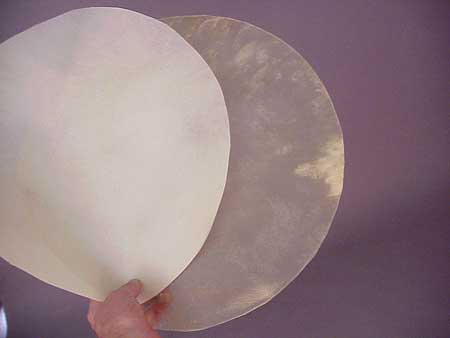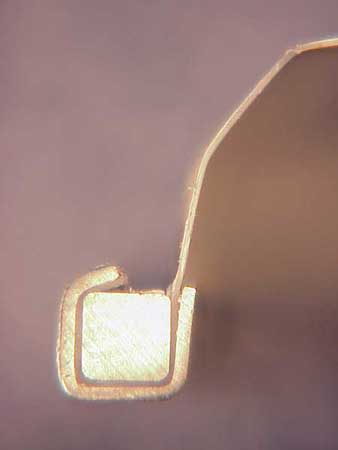Types and Structure
Banjo Heads
© Frank Ford, 7/10/00; Photos by FF, 7/10/00
Sometimes called the "vellum," the original banjo heads were made of calf
skin. Here I'm holding two of them:

On the left, the standard white skin head is the one preferred by most banjo players
before Mylar heads became available. Some players would specify a translucent "snare
drum head" which was generally thinner, providing the brightest sound.
The bad news about skin heads is that they are affected by ambient moisture. Wet
days would cause the head to become less tight, and the banjo to lose high end response.
Dry days would likely cause the head to shrink and tighten, often breaking.
The other bad news is that the head came as a flat disc, and had to be mounted on
a flesh hoop like this one:

The best flesh hoop was made of 1/8" square brass formed into a ring. It's
a bit of a pain to install
a skin head, and nowadays even the cost of the skin is
quite high because of low production quantities.
Starting in 1952, the Remo company has made synthetic banjo heads of Mylar. They
were, and are, branded "Weather King," for the obvious reason that they
are impervious to atmospheric moisture and therefore keep their tension constant.
There are basically six varieties available (not counting novelty colors):

Clockwise from the left (starting at 9:00): transparent clear, translucent clear,
solid white, translucent with white paint on the bottom, translucent with white paint
on the top, and simulated skin (Fibreskyn).
Each of these heads (theoretically) is available in any of 34 diameters from 10"
to 12-1/8, and with three "collar heights." It just takes a quick tap on
the calculator to come up with 612 different heads. Now, add the possibility of
different thicknesses of Mylar (.007" and .009" are the usual) and you
have a real "stocking nightmare."
Here at Gryphon, we have an unusually large selection, but we keep only the most
standard configuration, high collar with paint on the outside:

We do have all the diameters, though.
Fortunately, these days the 11" size is a virtual industry standard, so it's
usually only the old banjos we have trouble fitting. For the 11" size, it's
not unusual for us to have most of the six varieties lying around. But, as you can
imagine, we're constantly "out of stock" of many kinds.
Let's take a look at how these things are assembled.
Here's a typical Remo head:

The Mylar is formed over a mold, and tucks into an aluminum channel filled with epoxy.
I cut one apart so you can see it closely:

If you overtighten the head, or if it is very old, the Mylar can pull loose from
the epoxy channel:

You can see the perforations which allow the epoxy to grip the Mylar
Where the channel meets, it can separate a bit in time, or during installation:

This gap is an ideal starting point for the Mylar to pull loose, although it usually
does no harm if it is only a slight separation. All negative comments to the contrary,
the Remo head is a fine product and works so well it has existed unchanged for half
a century. It's not at all unusual to see very old Remo heads that work and sound
just the same as new one. As a matter of fact, banjo heads sound just fine for their
entire lives until they eventually fail from stress.
Now, look at this head:

It was developed around 30 years ago, and its mounting is very much stronger than
the Remo.
This Mylar head utilizes a 1/8" square steel rod formed into a ring, wrapped
with the plastic head, and capped with another steel form:

When the tension hoop bears down on it, the Mylar is securely clamped in the steel
ring. It is literally impossible to tear this head loose by overtightening. You
can break it, certainly, but it won't fail at the mounting ring.
This new type head is available from Stewart-MacDonald as the "Five Star"
brand, and is made only in the most standard of all possible sizes, 11" medium
collar. Other suppliers have a similarly made head, but I believe it was one of
the original "signature pieces" of the early Stewart MacDonald catalog.
Whether clear, white, or frosted, these heads can stand much higher tension than
the Remo heads. Bluegrass players and others who want the maximum brightness and
treble response use this head and crank it down tight.
Back to Index Page









